Aquarium Conditioned
Yellow Candy Hog Fish
Bodianus bimaculatus
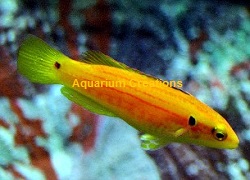
You Tube Video of the Yellow Candy Hog Fish
Description:
The Yellow Candy Hogfish is also called the Two spot Hogfish. A bright yellow fish with red horizontal stripes along with a black spot behind the eye and close to the tail. It easily adjusts to aquarium life and an aquarium diet. Candy Hogfish are often used to help control coral pests such as pyramid snails and harmful nudibranchs. This is one of the best hogfish for the smaller home aquarium. It is one of the smaller species, attaining a maximum length of 3.9 inches.
Tank Recommendations:
Can be maintained in a 30 gallon or larger reef or fish-only aquarium. Unlike a lot of the other fish, different types of hogfish can be mixed together in the same tank but you need to make sure the tank is large enough, has live rock for hiding spaces, and the size of each hogfish should be different. They won’t fight with each other but will develop a pecking order and usually stay out of each other’s way. Hogfish grow slowly so the size that you purchase them at will usually be the size they’ll stay for some time. Hogfish can be kept with aggressive fish but triggers, eels, and other very aggressive fish may harass it and take pieces out of its tail or fins. This could cause the hogfish to hide or be really stressed out and even die, so you need to be careful when mixing these fish together with other fish, even though they are large in size. They need hiding spaces and caves in the tank as they can be on the shy side. Small juvenile hogfish often have different markings but within a short time they change over to the adult colors. Small juveniles will also perform cleaning functions. This is a very hardy group of fish that does very well in FOWLR (fish only with Live Rock) tanks, though if you’re not going to have invertebrates, they would also do well in a reef tank.
Food and diet:
Feed a varied diet. For Frozen foods we like Formula 1 and 2 and other frozen meaty foods that include krill, shrimp, squid, clam and mussel.
Level of Care:
Moderate
Acclimaton Time:
2+ hours
Reef Compatibility
:Yes
Approximate Purchase Size:
Small 1-1/2" to 2" Medium 2" to 3" Large 3" to 4"
|
Small $59.99
Medium $63.99
Large $79.99
|
|
Aquarium Conditioned
Lyretail Hogfish
Pogonoperca punctata

You Tube Video of the Lyretail Hogfish
Description:
One of the most spectacular, and most divergent, of the hogfish species is Bodianus anthioides. It is easily recognized by its deeply incised to emarginate tail and its general form. In some ways it looks more like an anthias than a wrasse, hence its species name anthioides. An Orange, Red, and White fish with a long flowing tail, the Lyretail Hogfish has distinct patterns that have minor changes with maturity. This is a moderately aggressive fish that should only be housed with tankmates of similar temperament such as some Butterflyfish, Hawkfish, Rabbitfish, and Anthias. Adults may display temporary, and possibly permanent sexual dichromatism and appear to be sexually dimorphic, with males attaining larger sizes than females.
Tank Recommendations:
Can be maintained in a 75 gallon or larger aquarium. Unlike a lot of the other fish, different types of hogfish can be mixed together in the same tank but you need to make sure the tank is large enough, has live rock for hiding spaces, and the size of each hogfish should be different. They won’t fight with each other but will develop a pecking order and usually stay out of each other’s way. Hogfish grow slowly so the size that you purchase them at will usually be the size they’ll stay for some time. Hogfish can be kept with aggressive fish but triggers, eels, and other very aggressive fish may harass it and take pieces out of its tail or fins. This could cause the hogfish to hide or be really stressed out and even die, so you need to be careful when mixing these fish together with other fish, even though they are large in size. They need hiding spaces and caves in the tank as they can be on the shy side. Small juvenile hogfish often have different markings but within a short time they change over to the adult colors. Small juveniles will also perform cleaning functions. This is a very hardy group of fish that does very well in FOWLR (fish only with Live Rock) tanks, though if you’re not going to have invertebrates, they would also do well in a reef tank.
Food and diet:
Feed a varied diet. For Frozen foods we like Formula 1 and 2 and other frozen meaty foods that include krill, shrimp, squid, clam and mussel.
Level of Care:
Moderate
Acclimaton Time:
2+ hours
Reef Compatibility
No
Approximate Purchase Size:
Small: 1" to 2-1/2"; Medium: 2-1/2" to 4"; Large: 4" to 7"
|
Small $69.99
Medium $79.99
Large $99.99
|
Aquarium Conditioned
Coral Hog Fish
Bodianus mesothorax
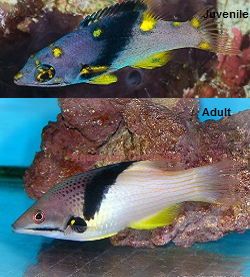
Click to view You Tube Video Coral Hog Fish
Description:
The Coral Hogfish, also known as Eclipse Hogfish is reddish-purple on the front half of it's body, separated from the yellow-gold back half by a diagonal black slash through the pectoral fin to the dorsal. It may also be called the Split level or Blackbelt Hogfish. If you are considering the Coral Hogfish, it is a very hardy fish but one of the least friendly of the Hogfish genus. Will nip at bivalves, clams, and even eels. This Hogfish does best kept in relatively aggressive aquarium with larger species that will not allow this fish to bully them.
Tank Recommendations:
Can be maintained in a 70 gallon or larger aquarium. Unlike a lot of the other fish, different types of hogfish can be mixed together in the same tank but you need to make sure the tank is large enough, has live rock for hiding spaces, and the size of each hogfish should be different. They won’t fight with each other but will develop a pecking order and usually stay out of each other’s way. Hogfish grow slowly so the size that you purchase them at will usually be the size they’ll stay for some time. Hogfish can be kept with aggressive fish but triggers, eels, and other very aggressive fish may harass it and take pieces out of its tail or fins. This could cause the hogfish to hide or be really stressed out and even die, so you need to be careful when mixing these fish together with other fish, even though they are large in size. They need hiding spaces and caves in the tank as they can be on the shy side. Small juvenile hogfish often have different markings but within a short time they change over to the adult colors. Small juveniles will also perform cleaning functions. This is a very hardy group of fish that does very well in FOWLR (fish only with Live Rock) tanks, though if you’re not going to have invertebrates, they would also do well in a reef tank.
Food and diet:
Feed a varied diet. For Frozen foods we like Formula 1 and 2 and other frozen meaty foods that include krill, shrimp, squid, clam and mussel.
Level of Care:
Moderate
Acclimaton Time:
2+ hours
Reef Compatibility
Juvenile-Yes Adult-No
Approximate Purchase Size:
Juvenile 1" to 2"; Medium: 1-1/2" to 3"; Large: 3" to 5"
|
Juvenile $29.99
Medium $39.99
Large $59.99
|
|
|
Aquarium Conditioned
Pacific Redstripe Hogfish
Bodianus sepiacaudus
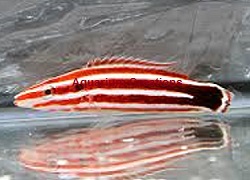
Click to view You Tube Video Redstripe Hogfish
Description:
The Pacific Redstripe Hogfish also called the Masudas Hogfish is a stunning and very colorful hogfish. They have a mostly white body with strong red horizontal stripes that can sometimes have a little hue to them. It also has a small black spot behind their eyes. Reaching a maximum adult size of around 5 inches, they need to be kept in tanks that are at least 55 gallons or larger. A peaceful fish they should get along with most other fish, coral and inverts in your tank. This makes the Pacific Redstripe Hogfish a great fish to add to a reef tank. Larger Pacific Redstripe Hogfish will sometimes bother smaller shrimp in reef tanks. They can be kept in small groups in larger tanks, but need to be introduced at the same time to help with aggression issues. The Pacific Redstripe Hogfishwill does the best if kept in tanks with lots of live rock for them to pick small inverts off of between feedings, and also to hide in if they feel threatened.
Tank Recommendations:
Unlike a lot of the other fish, different types of hogfish can be mixed together in the same tank but you need to make sure the tank is large enough, has live rock for hiding spaces, and the size of each hogfish should be different. They won’t fight with each other but will develop a pecking order and usually stay out of each other’s way. Hogfish grow slowly so the size that you purchase them at will usually be the size they’ll stay for some time. Hogfish can be kept with aggressive fish but triggers, eels, and other very aggressive fish may harass it and take pieces out of its tail or fins. This could cause the hogfish to hide or be really stressed out and even die, so you need to be careful when mixing these fish together with other fish, even though they are large in size. They need hiding spaces and caves in the tank as they can be on the shy side. Small juvenile hogfish often have different markings but within a short time they change over to the adult colors. Small juveniles will also perform cleaning functions. This is a very hardy group of fish that does very well in FOWLR (fish only with Live Rock) tanks, though if you’re not going to have invertebrates, they would also do well in a reef tank.
Food and diet:
Feed a varied diet. For Frozen foods we like Formula 1 and 2 and other frozen meaty foods that include krill, shrimp, squid, clam and mussel.
Level of Care:
Easy
Acclimaton Time:
2+ hours
Reef Compatibility
:Yes
Approximate Purchase Size:
Small: 1-1/4" to 1-1/2" Medium: 1-1/2" to 3" Large: 3" to 5-1/2"
|
Small$99.99
Medium $139.99
Large $159.99
|
Aquarium Conditioned
Spanish Hogfish
Bodianus rufus
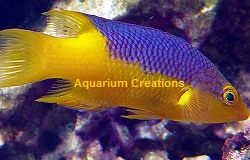
Description:
Spanish Hogfish are found along coral reefs throughout the Caribbean, where they inhabit relatively shallow water reefs looking for crustacean, invertebrate or small fish prey. They are a fairly large species of reef fish that typically reach upwards of 10" in length and have relatively stout build. The Spanish Hogfish does well with other large fish species like triggers, groupers, etc. and it renowned for their resistance to disease and overall strong constitution. They have attractive coloration and are strong active swimmers that do well in larger aquariums with other large fish tank mates. Spanish Hogfish should not be kept in a reef aquarium or with smaller less aggressive fish species, invertebrate or crustaceans as they will be seen as food items.
Tank Recommendations:
The Spanish Hogfish will need to be kept in a 150 gallon or larger fish-only tank. Unlike a lot of the other fish, different types of hogfish can be mixed together in the same tank but you need to make sure the tank is large enough, has live rock for hiding spaces, and the size of each hogfish should be different. They won’t fight with each other but will develop a pecking order and usually stay out of each other’s way. Hogfish grow slowly so the size that you purchase them at will usually be the size they’ll stay for some time. Hogfish can be kept with aggressive fish but triggers, eels, and other very aggressive fish may harass it and take pieces out of its tail or fins. This could cause the hogfish to hide or be really stressed out and even die, so you need to be careful when mixing these fish together with other fish, even though they are large in size. They need hiding spaces and caves in the tank as they can be on the shy side. Most hogfish will grow to roughly 1 foot in length though the Spanish Hogfish can get closer to 2 feet, while the Saddleback hogfigh stays a smaller size of roughly 6 inches. Small juvenile hogfish often have different markings but within a short time they change over to the adult colors. Small juveniles will also perform cleaning functions. This is a very hardy group of fish that does very well in FOWLR (fish only with Live Rock) tanks, though if you’re not going to have invertebrates, they would also do well in a reef tank.
Food and diet:
Feed a varied diet. For Frozen foods we like Formula 1 and 2 and other frozen meaty foods that include krill, shrimp, squid, clam and mussel.
Level of Care:
Easy
Acclimaton Time:
2+ hours
Reef Compatibility
:No
Approximate Purchase Size:
Small 1" to 2-1/2" Medium 2-1/2" to 4" Large 4" to 6" XLarge 6" to 8"
|
Small$39.99
Medium $59.99
Large $99.99
XLarge $219.99
|
Aquarium Conditioned
Cuban HogFish
Bodianus pulchellus
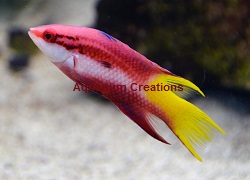
Click to view You Tube Video Cuban HogFish
Description:
The Cuban Hogfish, also known as the Spotfin Hogfish, is a species native to the Western Atlantic Ocean, ranging from the Carolinas and Bermuda to Honduras, Brazil, and Western Africa (Gulf of Guinea). Coloration changes as the fish matures, but is a striking combination of red, white, and yellow. In the wild, a full grown adult can reach up to 24 inches. This species typically inhabits rocky and coral reefs. The Cuban Hogfish forms harems in the wild, with the territory of one dominant male containing several females. Like other members of the species, they are protogynous and can change sex from female to male.
Tank Recommendations:
Unlike a lot of the other fish, different types of hogfish can be mixed together in the same tank but you need to make sure the tank is large enough, has live rock for hiding spaces, and the size of each hogfish should be different. They won’t fight with each other but will develop a pecking order and usually stay out of each other’s way. Hogfish grow slowly so the size that you purchase them at will usually be the size they’ll stay for some time. Hogfish can be kept with aggressive fish but triggers, eels, and other very aggressive fish may harass it and take pieces out of its tail or fins. This could cause the hogfish to hide or be really stressed out and even die, so you need to be careful when mixing these fish together with other fish, even though they are large in size. They need hiding spaces and caves in the tank as they can be on the shy side. Most hogfish will grow to roughly 1 foot in length though the Cuban and Spanish Hogfish can get closer to 2 feet, while the Saddleback hogfigh stays a smaller size of roughly 6 inches. Small juvenile hogfish often have different markings but within a short time they change over to the adult colors. Small juveniles will also perform cleaning functions. This is a very hardy group of fish that does very well in FOWLR (fish only with Live Rock) tanks, though if you’re not going to have invertebrates, they would also do well in a reef tank.
Food and diet:
Feed a varied diet. For Frozen foods we like Formula 1 and 2 and other frozen meaty foods that include krill, shrimp, squid, clam and mussel.
Level of Care:
Easy
Acclimaton Time:
2+ hours
Reef Compatibility
:No
Approximate Purchase Size:
Small 1-1/2" to 2-1/2" Medium 2-1/2" to 4" Large 4" to 6" XLarge 6" to 8"
|
Small$114.99
Medium $129.99
Large $169.99
XLarge $229.99
|
|
| |






